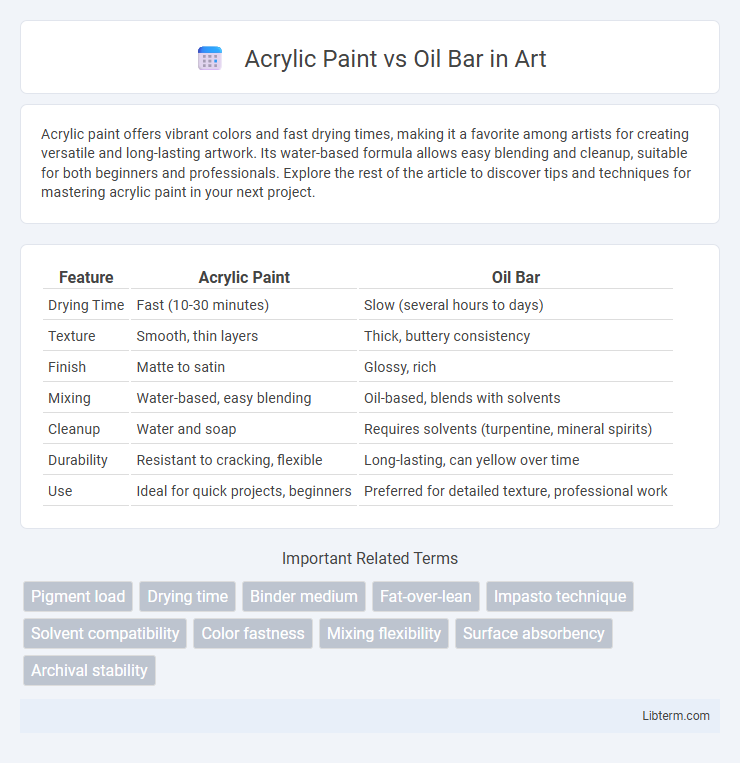Acrylic paint offers vibrant colors and fast drying times, making it a favorite among artists for creating versatile and long-lasting artwork. Its water-based formula allows easy blending and cleanup, suitable for both beginners and professionals. Explore the rest of the article to discover tips and techniques for mastering acrylic paint in your next project.
Table of Comparison
| Feature | Acrylic Paint | Oil Bar |
|---|---|---|
| Drying Time | Fast (10-30 minutes) | Slow (several hours to days) |
| Texture | Smooth, thin layers | Thick, buttery consistency |
| Finish | Matte to satin | Glossy, rich |
| Mixing | Water-based, easy blending | Oil-based, blends with solvents |
| Cleanup | Water and soap | Requires solvents (turpentine, mineral spirits) |
| Durability | Resistant to cracking, flexible | Long-lasting, can yellow over time |
| Use | Ideal for quick projects, beginners | Preferred for detailed texture, professional work |
Introduction to Acrylic Paint and Oil Bars
Acrylic paint is a fast-drying medium made from pigment suspended in an acrylic polymer emulsion, known for its versatility and vibrant colors suitable for various surfaces like canvas, wood, and paper. Oil bars combine the rich, buttery texture of traditional oil paint with the convenience of a crayon or pastel, allowing artists to draw directly on surfaces while retaining the slow drying time and blendability of oil. Both mediums offer unique tactile experiences and drying properties, influencing artistic techniques and finishes.
Composition and Ingredients
Acrylic paint is water-based, composed primarily of pigment suspended in an acrylic polymer emulsion, which dries quickly to form a flexible, water-resistant layer. Oil bars contain a blend of pigments mixed with drying oils like linseed or walnut oil, providing a thick, buttery consistency that dries slowly and allows for extended blending times. The key difference lies in the acrylic binder of acrylic paints versus the oil binder in oil bars, influencing drying time, texture, and finish.
Drying Time Comparison
Acrylic paint dries significantly faster than oil bars, typically within 15 to 30 minutes, making it ideal for artists seeking quick layering and fast project completion. Oil bars, composed of oil paint in stick form, require several days to weeks to fully dry due to their slow oxidation process. This extended drying time allows for prolonged blending and textural effects but demands more patience and careful storage to prevent smudging.
Color Vibrancy and Finish
Acrylic paint offers vibrant, intense colors with a quick-drying, flexible finish that resists cracking and maintains brightness over time. Oil bars deliver rich, luminous pigments with a buttery texture, resulting in a glossy, smooth finish that deepens the color intensity as it dries slowly. Both mediums provide excellent color vibrancy, but oil bars excel in achieving a luminous, textured finish while acrylics provide more versatility and faster curing.
Ease of Use and Application Techniques
Acrylic paint offers fast drying times and easy water cleanup, making it ideal for beginners seeking convenience and quick layering techniques. Oil bars, combining the rich texture of oil paints with the direct application of pastels, require more skill due to longer drying times and blending complexity. Mastery of oil bars involves controlled pressure and layering for smooth transitions, while acrylics benefit from brushwork and palette knife versatility.
Surface Compatibility
Acrylic paint adheres effectively to a wide range of surfaces including canvas, wood, paper, and fabric due to its fast-drying, water-based formulation. Oil bars, containing oil paint in a stick form, perform best on primed or non-porous surfaces such as canvas, wood panels, and specially prepared paper, allowing for smooth blending and layer buildup. Compatibility with surface texture and absorbency is crucial for maximizing vibrancy and longevity in both mediums.
Blending and Layering Capabilities
Acrylic paint dries quickly, allowing for fast layering but limiting extensive blending time, making it ideal for sharp transitions and textured effects. Oil bars, containing slow-drying oil paint in a solid stick form, provide exceptional blending capabilities with smooth, seamless gradients and subtle tonal variations due to their extended working time. Layering with oil bars benefits from the paint's flexibility and richness, enabling artists to build depth and luminosity through multiple translucent layers without compromising blend quality.
Longevity and Durability
Acrylic paint offers exceptional longevity and durability due to its fast-drying, water-resistant properties, making it less prone to cracking and yellowing over time. Oil bars, composed of oil paint in stick form, provide rich, vibrant colors with a slower drying process that can increase risk of dust accumulation and potential surface damage if not properly sealed. For artworks requiring lasting preservation, acrylics generally outperform oil bars in resisting environmental factors and maintaining color stability.
Cleanup and Maintenance
Acrylic paint requires water for cleanup, enabling quick and easy removal from brushes and surfaces before it dries, while oil bars demand solvents such as turpentine or mineral spirits for effective cleaning. Maintaining acrylic tools involves rinsing immediately after use to prevent paint hardening, whereas oil bars necessitate careful handling and storage to avoid smudging and to preserve their texture. Regular cleaning with appropriate solvents ensures longevity of oil bar brushes, contrasting with the effortless maintenance of acrylic supplies.
Best Uses and Artistic Styles
Acrylic paint excels in versatility and quick drying, making it ideal for detailed work, mixed media, and vibrant abstract styles, while oil bars offer rich textures and extended blending time, suited for expressive impasto techniques and classical realism. Artists often choose acrylic for contemporary, fast-paced projects and outdoor murals due to its durability and water resistance. Oil bars are preferred in portraiture and landscapes where subtle gradations and depth are essential.
Acrylic Paint Infographic

 libterm.com
libterm.com